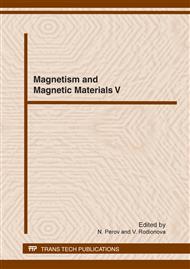[1]
Y. Shapira, S. Foner, P. Becla, D. N. Domingues, M. J. Naughton and J. S. Brooks, Phys. Rev. B33, 356 (1986).
Google Scholar
[2]
S. Isber, M. Averous, Y. Shapira, V. Bindilatti, A. N. Anisimov, N. F. Oliveira, Jr., V. M. Orera and V. Demianiuk, Phys. Rev. B51, 15211 (1995).
DOI: 10.1103/physrevb.51.15211
Google Scholar
[3]
M. Gorska and J. R. Anderson, Phys. Rev. B38, 9120 (1988).
Google Scholar
[4]
A. Lewicki, J. Spalek and A. Mycielski, J. Phys. C20, 2005 (1987).
Google Scholar
[5]
A. Jwardowski, J. Appl. Phys. 67, 5108 (1990).
Google Scholar
[6]
S. Isber, P. Masri, S. Charar, X. Gratens and S. K. Misra, J. of Physics. C9, 10023 (1997).
Google Scholar
[7]
V. Jovovic, S. J. Thiagarajan, J. West, J. P. Heremans, T. Story, Z. Golacki, W. Paszkowicz, and V. Osinniy, J. Appl. Physics 102, 043707 (2007).
DOI: 10.1063/1.2771048
Google Scholar
[8]
J. P. Heremans, C. M. Thrush, and D. T. Morelli, J. Appl. Phys. 98, 063703 (2005).
Google Scholar
[9]
J. Heremans and D. L. Partin, Phys. Rev. B 37, 6311 (1988).
Google Scholar
[10]
S. Isber, S. Misra, S. Charar, X. Gratens, M. Averous, Z. Golacki, Phys. Rev. B56, 13724 (1997).
Google Scholar
[11]
X. Gratens, S. Isber, S. Charar, C. Fau, M. Averous, S. K. Misra, Z. Golacki, M. Ferhat and J. Tedenac, Phys. Rev. B55, 8075 (1997); S. Isber, S. Charar, X. Gratens, C. Fau, M. Averous, S. K. Misra and Z. Golacki, Phys. Rev. B54, 7634 (1996).
DOI: 10.4028/www.scientific.net/msf.182-184.657
Google Scholar
[12]
X. Gratens, E. ter Haar, V. Bindilatti, N.F. Oliveira, Y. Shapira, Z. Golacki, J . Magn Magn Mater 226, 2036 (2001).
DOI: 10.1016/s0304-8853(00)01079-9
Google Scholar
[13]
X. Gratens, V. Bindilatti, V. A. Chitta, and N. F. Oliveira, Jr., S. Isber and Z. Golacki Phys. Rev. B79, 075207 (2009).
Google Scholar
[14]
J. R. Anderson, G. Kido, Y. Nishina, M. Gorska, L. Kowalczyk and Z. Golacki, Phys. Rev. B 41, 1014 (1990).
Google Scholar
[15]
J. A. Gaj, R. Planeland G. Fishman, Solid state Commun. 29, 435 (1979).
Google Scholar
[16]
X. Gratens, V. Bindilatti, N.F. Oliveira, Z. Golacki, Physica B329-333, 1245 (2003).
Google Scholar
[17]
F. Hulliger, B. Natterer and H. R. Ott, J. Magn. Magn. Matter. 8, 87 (1978).
Google Scholar
[18]
H. R. Ott, J. K. Kjems and F. Hulliger, Phys. Rev. Lett. 42, 1378 (1979).
Google Scholar
[19]
M. Gorska and J. R. Anderson, Acta Physica Polonica A75, 273 (1989).
Google Scholar


